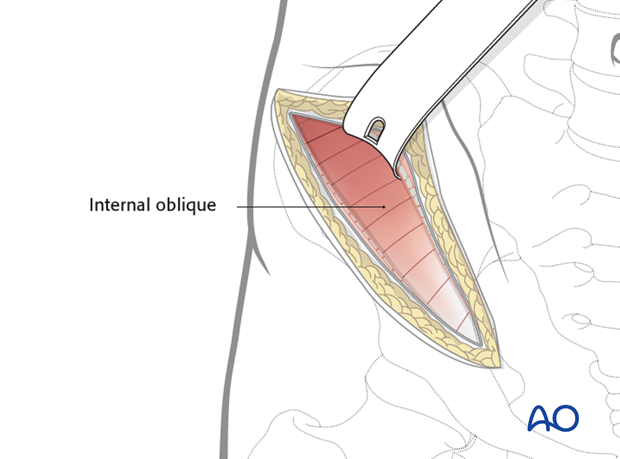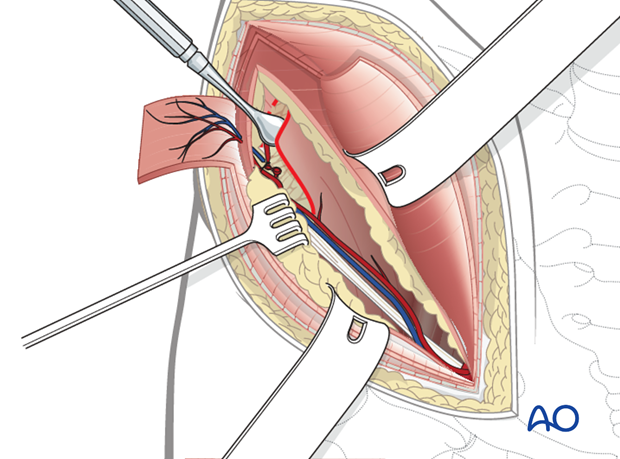Iliac crest
1. Introduction
Vascular anatomy
The vascular system will depend on the deep circumflex iliac artery (DCIA) which has a diameter of 1.5 -2.0 mm.
The concomitant vein has a diameter of 2.5 – 3.0 mm.
The length of the pedicle is limited to around 5 cm.
The ascending branch is located beneath internal oblique muscle running superiorly.
The DCIA is located beneath the transverse abdominis in the groove between the transverse abdominis and the iliacus fossa.

There are three main anatomical variations of the ascending branch, which will have an influence on the flap harvest.
In 65 % of the cases, the ascending branch originates from the DCIA wihin one cm medial to the ASIS.
In 20 % of the cacses there is no single dominant ascending branch. The internal oblique is supplied by a series of small branches of the DCIA.
In 15 % of the cases ascending branch originates in a more medial location.

Muscular anatomy
When dissecting through the external oblique, the internal oblique and the transverse abdominis muscle one can readily recognize the muscle layers by the direction of the muscle fibers.
The muscle fibers of the external oblique muscle run inferiomedially.
The muscle fibers of the internal oblique muscle run superiomedially perpendicular to the external oblique muscle fibers.
The muscle fibers of the transverse abdominus muscle run medially.

Design of flap
The following landmarks are identified and marked:
- The anterior superior iliac spine (ASIS)
- The midpoint of the inguinal ligament (Femoral artery is palpable)
- Superior border of the iliac crest

The harvested myo osseous flap should include:
- DCIA
- Iliac crest
- Internal oblique muscle
- Ascending Branch
Although a relatively large bone flap (up to 18 cm) can be harvested, large bone flaps may lead to higher risk of donor site morbidity (e.g: hernia, disfigurement, gait disturbance).

The standard size is around 10 cm in length and up to 5 cm in height.
A S-shaped incision is used starting at the superior border of the iliac crest (with the assistant pulling the overlying skin medially, thereby, end result of surgical scar will be resting laterally on bone edge in avoiding long term abrasion irritation of clothing), curving medially through the anterior superior iliac spine and curving inferiorly through the midpoint of the inguinal ligament.
The exact osteotomy line will depend on the planned reconstruction. We will here show the harvest of a straight segment(s) used for mandibular body reconstruction.

Main structures involved in the flap harvest
The main layers and structures encountered during the flap harvest are:
- Skin
- Iliac crest
- External oblique
- Internal oblique
- The ascending branch
- Transverse abdominus muscle
- Deep circumflex iliac artery (DCIA)
- Iliacus muscle

Patient positioning
For the harvest the patient is placed supine with the buttocks elevated on the donor site by using eg. a bean bag.

2. Flap harvest with internal oblique muscle
The skin is incised and dissection is carried down to the external oblique fascia.

The external oblique fascia (as external oblique running laterally, it is very thin and almost only fascia can be seen) is incised and retracted to expose the internal oblique muscle.

If the internal oblique muscle is harvested together with the bone flap, the maximum internal oblique muscle that can be harvested, starting 2 cm laterally from the midline and end at the iliac crest.
The internal oblique muscle is incised as needed and raised laterally. The ascending branch of the DCIA running on the undersurface of the muscle is identified.

Retrograde dissection is performed along the ascending branch to the main trunk (External Illiac Atery). The dissection is then continued until the bifurcation of the external iliac artery is reached.
Now, dissect antegradly to identify the DCIA.There is a variation where the Ascending branch can arise from the DCIA or directly from External Illiac Artery.

Dissection is now carried superiolaterally along the DCIA through and beneath the transverse abdominal muscle.
An incision of the transverse abdominal muscle is along the dissection of DCIA or 2 cm medially to the iliac crest.

The distal end of the DCIA is ligated.

The iliacus is incised to expose the osteotomy sites. In order to protect the DCIA, the incision is made 1-2 cm inferior to the groove where the DCIA is located.

Osteotomy
The osteotomy is performed according to the planned outline.

When the reconstruction site is ready, the pedicle can be transected.

3. Harvest without internal oblique muscle
The skin is incised and dissection is carried down to the external oblique fascia.

The external oblique fascia is incised and retracted to expose the internal oblique muscle.

The transverse abdominal muscle and the inguinal ligaments are identified.
The external iliac artery can be found by palpation at midpoint of the inguinal ligaments.
Meticulous blunt dissections are performed along the external iliac artery. The DCIA is identified by its course emerging laterally from the external iliac artery and entering the groove between transverse abdominous muscle and the iliac fossa.

Dissection is now carried superiolaterally along the DCIA through and beneath the transverse abdominal muscle.
An incision of the transverse abdominal muscle is made from the inferior border to the planned resection site. The incision is made 2 cm medially to the iliac crest.

The distal end of the DCIA is ligated.

The iliacus is incised to expose the the inner table of Illiac bone prepared for osteotomy. In order to protect the DCIA, the incision is made 1-2 cm inferior to the illiacus groove where the DCIA is located.

Osteotomy
The osteotomy is performed according to the planned outline.

When the reconstruction site is ready, the pedicle can be transected.

Closure
The transverse abdominis muscle is sutured to the iliacus.

Harvest without internal oblique:
The cut edges of the external oblique, internal oblique and transversus abdominus muscles are then reapproximated using resorbable horizontal mattress sutures.

Harvest with internal oblique:
The cut edges of the external oblique, internal oblique and transversus abdominus muscles are then reapproximated using resorbable horizontal mattress sutures.
If a large piece of the internal oblique is harvested, closure of that layer can be accomplished using a mesh that will be sutured to the remaining muscles.

A drain is inserted between the transverse abdominous muscle and internal oblique/external oblique muscles. the skin closed in primary fashion. Pressure dressing is then applied.














